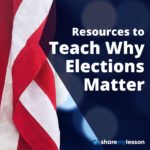Is a public school that refuses to let a religious club use its facilities violating the Free Speech Clause of the Constitution? This case summary shows how the Supreme Court answered that question in 2001.
What Is ‘Fake News’ And How Does It Impact Our Lives?
This deliberation will have students view short video clips and news articles to analyze the effect of fake news on traditional media outlets, the reasons and incentives for purveyors of “fake news,” and provide students with resources to strengthen their media literacy skills. Students will use this information to develop strategies to identify “fake news” and improve their news literacy.
IRL 1: Free Speech in Schools Podcast
We’re digging into four incredibly important Supreme Court cases – four cases that have shaped how we interpret the meaning of free speech in public schools. Is political protest allowed in class? Is lewd speech covered by the First Amendment? Can school administrators determine what students can and can’t say in the school newspaper? Listen in, and find out how students and schools have gone head to head over how First Amendment rights apply in a public school setting.
Constitution Day Writing Prompts – Middle and High School
Three writing prompts for Constitution Day are provided for middle school and high school. The prompts can be used as a formal essay, at writing stations, or as a “discuss and write.”
What Does It Mean to Be a Good Citizen?
This is the first lesson in Khan Academy’s new high school civics course. This lesson focuses on what it means to be a good citizen, what civil society is, and what are democratic principles and civic virtues.
Civic Art Project: Notes on the Constitution
Students create art works based on an examination of the language of the Constitution and the personal connections they make. These art works will incorporate words, illustrations, and mixed media images.
This lesson can be adapted for different grade levels. High school students can use an abridged version of the U.S. Constitution. Elementary and middle school students can use the Preamble, or introduction, to the Constitution.
Civic Art Project: From Her Beacon
Students will work collaboratively to create a mural of the Statue of Liberty to show the statue as a representation of freedom and a symbol of welcome to immigrants coming from other countries. This lesson can be adapted for different grade levels. High school students will read a poem and incorporate some of its ideas into their mural. Elementary and middle school students will incorporate words and phrases inspired by the statue into their mural. This activity supports Art, Social Studies, Civics, and English Language Arts standards and can be used as a cross-curricular project across these classrooms. Teachers across the curricula are encouraged to work together to bring this activity to life.
Civic Education and Election Resources

It’s election season in the United States and a good time for students to understand why local and national politics matter and the core principles on how our democracy and elections works. What is gerrymandering? How can we strengthen our democracy? Plan how to answer questions like these as Election Day draws closer. Use these free K-12 civic education lessons, activities, blogs and webinars to help you educate students on the election and the importance of counting every vote. Additional topics include fostering civil discourse, fighting fake news, voting rights and debate ideas to keep your students informed and engaged.
U.S. Capitol Tour, Worksheet, Quiz – Middle School
This 3-room video tour of the U.S. Capitol, featuring the Crypt, Rotunda, and National Statuary Hall, focuses on information relevant to students taking middle school level U.S. history and civics courses. A follow-along worksheet and a follow-along quiz are provided.
Bullying and Speech Policies in Your School and Community
Students use a poem to discuss bullying and then explore policies within their school, community, and state.